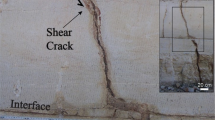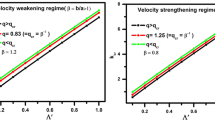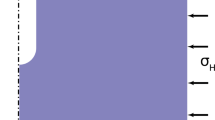Abstract
The rate-dependent mechanism is analyzed for frictional contact between a blunt tool and a fluid-infiltrated porous rock under pressurized condition. The dimensional analysis is adopted to derive a dimensionless number \(\lambda\) that predominantly governs the rate-dependent mechanism from pore pressure diffusion. The governing nature of \(\lambda\) is analyzed by finite element modeling using the software ABAQUS for an idealized plane strain frictional contact problem. After validating the finite element model against analytical solutions for special cases, the rate-dependent frictional contact is analyzed for poroelastic, poroelastoplastic, rigid-poroplastic, and elasto-visco-plastic rocks, respectively. Three pore pressure regimes exist depending on \(\lambda\): low speed (0 < \(\lambda\) ≲ 10–1), transient (10–1 ≲ \(\lambda\) ≲ 103), and high speed (\(\lambda\) ≳ 103). The pore pressure generally increases, and the average effective contact stress decreases with increasing \(\lambda\) for a poroelastic rock and a typical poroelastoplastic rock. The average effective contact stress generally decreases with increasing \(\lambda\) for a rigid-poroplastic rock at a small dilatancy angle due to compactive weakening, but increases with \(\lambda\) at a large dilatancy angle due to dilatant strengthening. A transition occurs from compactive weakening to dilatant strengthening with increasing the dilatancy angle. The average effective contact stress increases with decreasing the interface friction angle for a rigid-poroplastic rock. It is inferred from numerical results that the high-speed regime dominates with cavitation for frictional contact on shales in deep drilling, and that the strain rate effect is negligible in typical experiments on dry rocks at ambient pressure.


















Similar content being viewed by others
References
Adachi J (1996) Frictional contact in rock cutting with blunt tools. MS Thesis, University of Minnesota, Minneapolis, MN
Alehossein H, Hood M (1999) An application of linearised dimensional analysis to rock cutting. Int J Rock Mech Min Sci 36(5):701–709
Amri M, Pelfrene G, Jahangir E, Tijani M, Sellami H (2018) Numerical and analytical study of rate effects on drilling forces under bottomhole pressure. Int J Rock Mech Min Sci 110:189–198
Arson C, Gatmiri B (2012) Thermo-hydro-mechanical modeling of damage in unsaturated porous media: theoretical framework and numerical study of the EDZ. Int J Numer Anal Methods Geomech 36(3):272–306
Bemabe Y, Brace W (1990) Deformation and fracture of Berea sandstone. In: Duba AG, Durham WB, Handin JW, Wang HF (eds) The brittle-ductile transition in rocks, geophysical monograph. American Geophysical Union, Washington, pp 91–101
Brace W, Paulding B Jr, Scholz C (1966) Dilatancy in the fracture of crystalline rocks. J Geophys Res 71(16):3939–3953
Caligaris M, Ateshian GA (2008) Effects of sustained interstitial fluid pressurization under migrating contact area, and boundary lubrication by synovial fluid, on cartilage friction. Osteoarthr Cartil 16(10):1220–1227
Chen P, Miska SZ, Ren R, Yu M, Ozbayoglu E, Takach N (2018) Poroelastic modeling of cutting rock in pressurized condition. J Pet Sci Eng 169:623–635
de Souza Neto EA, Peric D, Owen DR (2008) Computational methods for plasticity: theory and applications. John Wiley & Sons Inc, New York
Delavoipière J, Tran Y, Verneuil E, Heurtefeu B, Hui CY, Chateauminois A (2018) Friction of poroelastic contacts with thin hydrogel films. Langmuir 34(33):9617–9626
Detournay E, Atkinson C (2000) Influence of pore pressure on the drilling response in low-permeability shear-dilatant rocks. Int J Rock Mech Min Sci 37(7):1091–1101
Detournay E, Cheng AH-D (1993) Fundamentals of poroelasticity. In: Fairhurst C (ed) Comprehensive rock engineering: principles, practice, and projects analysis and design method, vol 2. Pergamon Press, Oxford, pp 113–171
Detournay E, Defourny P (1992) A phenomenological model for the drilling action of drag bits. Int J Rock Mech Min Sci Geomech Abstr 29(1):13–23
Ehrenberg SN, Nadeau PH, Steen Ø (2008) A megascale view of reservoir quality in producing sandstones from the offshore Gulf of Mexico. AAPG Bull 92(2):145–164
Fitzgerald M, Elsworth D (2010) Evolution of the pore-pressure field around a moving conical penetrometer of finite size. J Eng Mech 136(3):263–272
Gauthier C, Lafaye S, Schirrer R (2001) Elastic recovery of a scratch in a polymeric surface: experiments and analysis. Tribol Int 34(7):469–479
Gregor M (1970) Influence of cutting velocity on the cutting- and thrust forces of coal. Glückauf Forschungshefte 29:179–188
Helmons R, Miedema S, Grima MA, van Rhee C (2016) Modeling fluid pressure effects when cutting saturated rock. Eng Geol 211:50–60
Hibbitt HD, Karlsson BI, Sorensen P (2001) ABAQUS/standard user's manual. Hibbitt, Karlsson & Sorensen, Inc., Pawtucket
Hinchberger SD, Qu G (2009) Viscoplastic constitutive approach for rate-sensitive structured clays. Can Geotech J 46(6):609–626
Hinchberger SD, Qu G, Lo K (2010) Constitutive approach for rate-sensitive anisotropic structured clays. Int J Numer Anal Meth Geomech 34(17):1797–1830
Huang H, Detournay E (2008) Intrinsic length scales in tool-rock interaction. Int J Geomech 8(1):39–44
Islam M, Skalle P (2013) Experimentally evaluating shale dilation behavior. In: Chatellier J, Jarvie D (eds) Critical assessment of shale resource plays. AAPG, Tulsa, pp 121–132
Johnson KL (1970) The correlation of indentation experiments. J Mech Phys Solids 18(2):115–126
Johnson KL (1987) Contact mechanics. Cambridge University Press, London
Lajtai E, Duncan ES, Carter B (1991) The effect of strain rate on rock strength. Rock Mech Rock Eng 24(2):99–109
Menezes PL, Lovell MR, Avdeev IV, Higgs CF (2014) Studies on the formation of discontinuous rock fragments during cutting operation. Int J Rock Mech Min Sci 71:131–142
Moore A, Burris D (2014) An analytical model to predict interstitial lubrication of cartilage in migrating contact areas. J Biomech 47(1):148–153
Neuzil C (1994) How permeable are clays and shales? Water Resour Res 30(2):145–150
Nishimatsu Y (1979) On the effect of tool velocity in the rock cutting. In: Proceedings of the international conference on mining and machinery, Brisbane, pp. 314–319
Nishimatsu Y (1993) Theories of rock cutting. In: Brown ET (ed) Comprehensive rock engineering: principles, practice, and projects, vol 1. fundamentals. Pergamon Press, Oxford, pp 647–662
Osinov VA, Chrisopoulos S (2020) Two neighbouring tunnels in saturated soil under blast loading. In: Triantafyllidis T (ed) Recent developments of soil mechanics and geotechnics in theory and practice. Springer, Switzerland, pp 281–296
Pawaskar SS, Fisher J, Jin Z (2010) Robust and general method for determining surface fluid flow boundary conditions in articular cartilage contact mechanics modeling. J Biomech Eng 132:031001–1-031001–8
Perzyna P (1963) The constitutive equations for rate sensitive plastic materials. Q Appl Math 20(4):321–332
Potts D (2003) Numerical analysis: a virtual dream or practical reality? Géotechnique 53(6):535–573
Reale ER, Dunn AC (2017) Poroelasticity-driven lubrication in hydrogel interfaces. Soft Matter 13(2):428–435
Richard T, Germay C, Detournay E (2007) A simplified model to explore the root cause of stick–slip vibrations in drilling systems with drag bits. J Sound Vib 305(3):432–456
Richard T, Dagrain F, Poyol E, Detournay E (2012) Rock strength determination from scratch tests. Eng Geol 147:91–100
Roscoe KH, Burland J (1968) On the generalized stress-strain behaviour of wet clay. In: Heyman J, Lekie FA (eds) Engineering plasticity. Cambridge University Press, London, pp 535–609
Rostamsowlat I (2018) Effect of cutting tool properties and depth of cut in rock cutting: an experimental study. Rock Mech Rock Eng 51(6):1715–1728
Rostamsowlat I, Akbari B, Evans B (2018) Analysis of rock cutting process with a blunt PDC cutter under different wear flat inclination angles. J Pet Sci Eng 171:771–783
Rostamsowlat I, Richard T, Evans B (2019) Experimental investigation on the effect of wear flat inclination on the cutting response of a blunt tool in rock cutting. Acta Geotech 14(2):519–534
Scholz C, Engelder JT (1976) The role of asperity indentation and ploughing in rock friction—I: Asperity creep and stick-slip. Int J Rock Mech Min Sci Geomech Abstr 13(5):149–154
Shao J-F, Jia Y, Kondo D, Chiarelli A-S (2006) A coupled elastoplastic damage model for semi-brittle materials and extension to unsaturated conditions. Mech Mater 38(3):218–232
Sone H, Zoback MD (2013) Mechanical properties of shale-gas reservoir rocks—Part 1: Static and dynamic elastic properties and anisotropy. Geophysics 78(5):D381–D392
Van Kesteren W (1995) Numerical simulations of crack bifurcation in the chip forming cutting process in rock. In: Baker G, Karihaloo BL (eds) Fracture of brittle disordered materials: concrete, rock and ceramics. CRC Press, London, pp 505–524
Voyiadjis GZ, Zhou Y (2019) Numerical modeling of frictional contact between a blunt tool and quasi-brittle rock. Rock Mech Rock Eng 52:3771–3790
Wang HF (2000) Theory of linear poroelasticity with applications to geomechanics and hydrogeology. Princeton University Press, Princeton
Zhou Y (2017a) The applicability of correspondence rule with inclined load. Rock Mech Rock Eng 50(1):233–240
Zhou Y (2017b) Misinterpretation of friction as fracture in shallow scratch tests with classical and universal size effect laws. Eng Fract Mech 184:14–21
Zhou Y, Detournay E (2014) Analysis of the contact forces on a blunt PDC bit. In: 48th US Rock mechanics/geomechanics symposium, Minneapolis, MN
Zhou Y, Zhang W, Gamwo I, Lin J-S (2017) Mechanical specific energy versus depth of cut in rock cutting and drilling. Int J Rock Mech Min Sci 100:287–297
Acknowledgements
This work was funded by the Center for GeoInformatics (C4G) at the Louisiana State University. The authors gratefully acknowledge two reviewers for their constructive comments.
Author information
Authors and Affiliations
Corresponding author
Additional information
Publisher's Note
Springer Nature remains neutral with regard to jurisdictional claims in published maps and institutional affiliations.
Rights and permissions
About this article
Cite this article
Zhou, Y., Voyiadjis, G.Z. Rate Effect in Frictional Contact on Porous Rocks. Rock Mech Rock Eng 54, 1411–1430 (2021). https://doi.org/10.1007/s00603-020-02317-7
Received:
Accepted:
Published:
Issue Date:
DOI: https://doi.org/10.1007/s00603-020-02317-7




